Key takeaways:
- GIMP templates offer a structured starting point that enhances creativity and saves time in design projects.
- Effective templates have organized layers, clear typography, and appealing color schemes, which can significantly enhance the emotional impact of designs.
- Personalizing templates by adjusting elements and incorporating original images creates a meaningful connection with the audience.
- Maximizing template effectiveness involves examining all layers, using GIMP’s tools for precision, and selecting the right export formats to maintain quality.
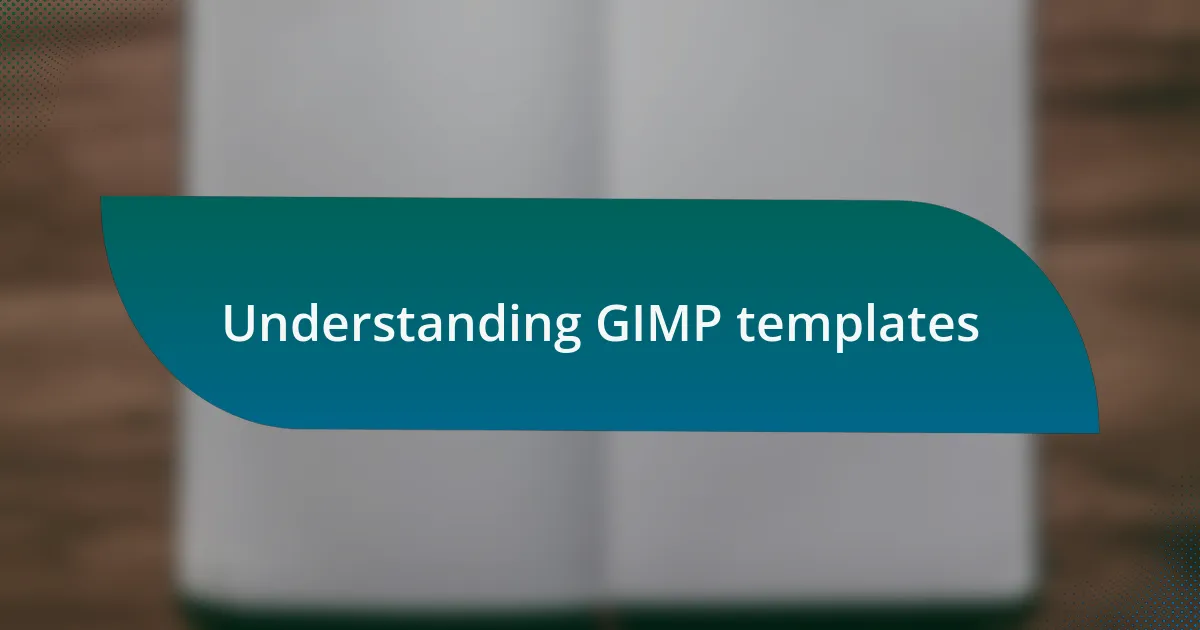
Understanding GIMP templates
GIMP templates serve as a fantastic foundation for your creative projects, providing a structured layout that can save you time and frustration. I remember my early days of graphic design when I would spend hours trying to figure out the right dimensions and formats. Discovering templates that already had these elements defined was like finding a treasure chest of design possibilities. Have you ever felt overwhelmed by empty white space on your canvas? A well-designed template can guide your creativity and give you a starting point.
One of the intriguing aspects of GIMP templates is their versatility. You can modify them to fit various themes, whether you’re designing for social media, a website, or even print materials. For instance, I once stumbled upon a template meant for a wedding invitation that I transformed into a promotional flyer for an event. This adaptability speaks volumes about how templates can cater to different design needs while still feeling unique.
Moreover, it’s essential to understand the elements that make a GIMP template effective. Look for templates with well-organized layers, clear typography, and appealing color schemes. I find myself often tweaking layers and colors based on my project vibe, which enhances my work and makes it feel more personal. Have you considered how a template’s layout influences the emotion it evokes? This understanding of design fundamentals can elevate your projects and help you relate to your audience more effectively.
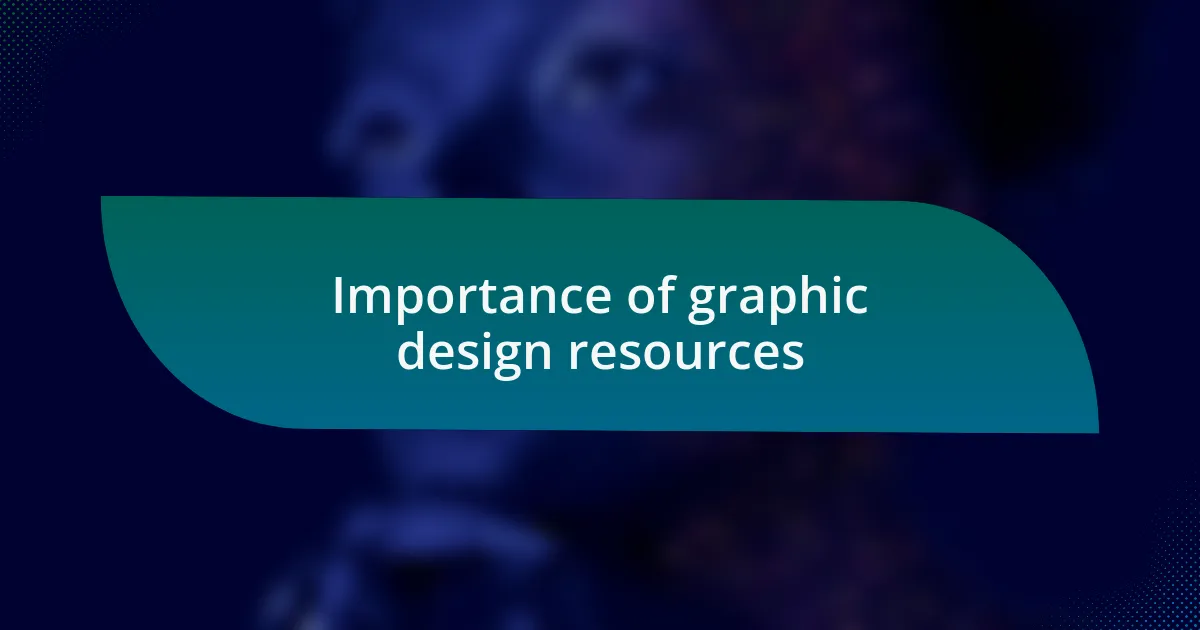
Importance of graphic design resources
Graphic design resources are essential tools that empower creatives to elevate their work. I vividly remember the first time I accessed a high-quality graphic resource library. It felt like stepping into a world where I could explore an array of textures, fonts, and illustrations that sparked my creativity. Have you ever wondered how much easier it is to develop a concept when you have the right resources at your fingertips? They not only minimize the hassle of starting from scratch but also inspire innovation by providing new ideas that you might not have considered before.
Having access to a variety of graphic design resources significantly enhances the quality and efficiency of your work. For instance, when I decided to create a brand identity for a friend’s coffee shop, I turned to my collection of logos and color palettes for inspiration. By pulling elements from different resources and combining them, I crafted a cohesive identity that captured the essence of their vision. How might your projects transform if you had immediate access to a toolkit full of templates and graphics that resonate with your style?
Moreover, the importance of graphic design resources extends beyond merely making our jobs easier; they also play a critical role in educational growth. Each resource provides an opportunity to learn different techniques and styles, fostering personal development as creators. I often find myself dissecting a beautifully designed template to understand the choices made by the designer. Isn’t it fascinating how even something as simple as a color choice or font selection can open up new avenues of thought in your design process? Engaging with these resources not only enriches our projects but also nurtures our skills as designers.
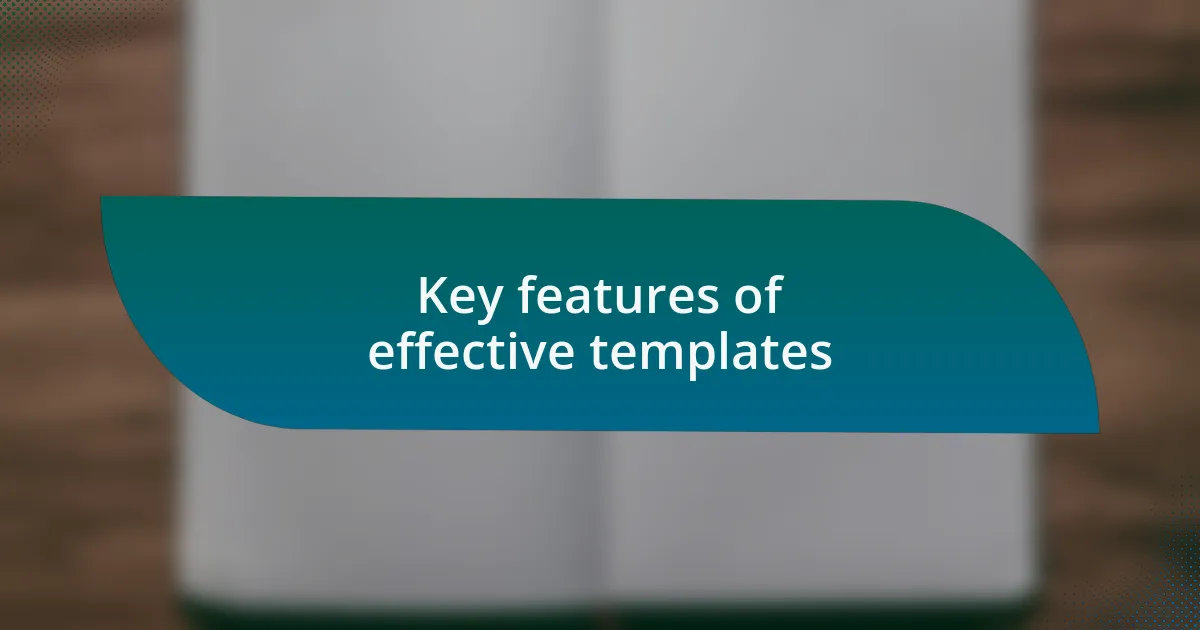
Key features of effective templates
Effective templates share several key features that enhance both their usability and aesthetic appeal. First and foremost, they exhibit a clear and organized structure, allowing users to easily navigate elements without feeling overwhelmed. I remember using a cluttered template once; it took me ages to locate the right sections! A well-structured template, on the other hand, enables a smoother workflow, letting creativity flow with minimal interruptions.
Another vital aspect is adaptability. The best templates can be easily customized to suit various styles and themes. When I worked on a promotional banner for a local event, I found a template that was straightforward to tweak, enabling me to align it seamlessly with the event’s branding. Have you ever struggled with a design that just wouldn’t fit your vision? Templates that offer flexible options make it simpler to experiment and borrow ideas while staying true to your unique voice.
Lastly, effective templates often include high-quality visuals and thoughtfully selected color palettes. I recall using a template adorned with vibrant colors that genuinely captured attention. It made my project stand out while also conveying the desired mood. How can your designs benefit from rich visuals and cohesive color schemes? By leveraging templates that prioritize these elements, you can create designs that resonate deeply with your audience, enhancing emotional connection and impact.
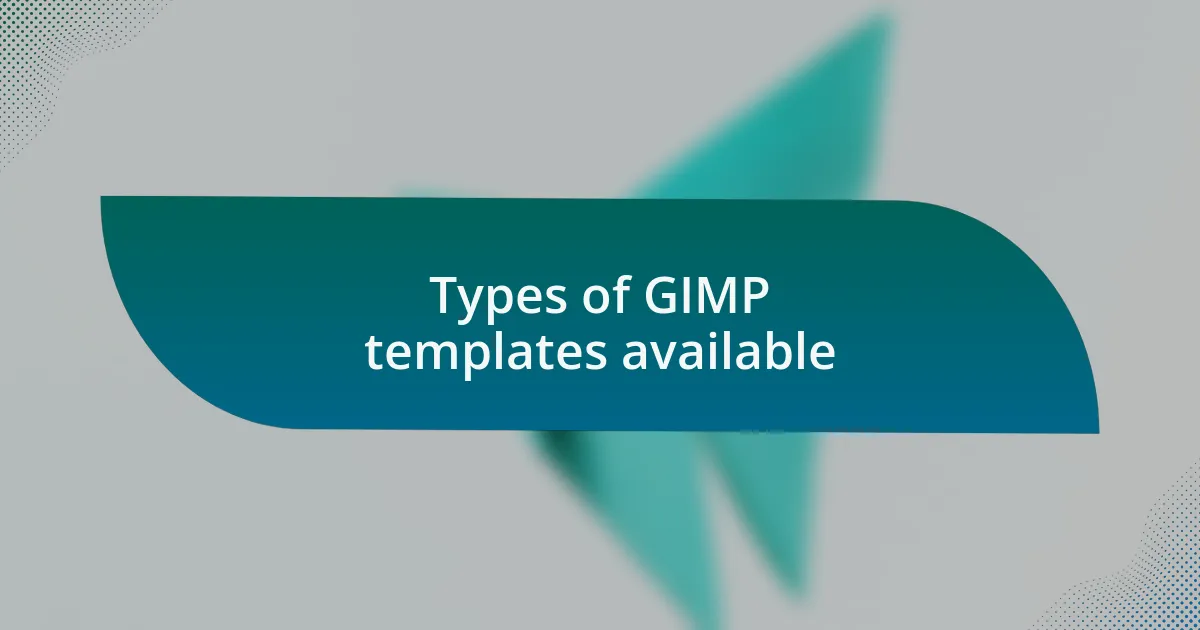
Types of GIMP templates available
GIMP offers a variety of templates suited for different design projects. One popular type is the logo template, which can streamline the creation of unique branding for businesses. I remember when I designed my first logo; using a template helped me focus on creativity rather than getting bogged down in the technical details of design.
Another commonly used category includes social media templates. These are ideal for creating eye-catching posts and ads that resonate with your target audience. I find that selecting a well-crafted social media template allows me to maintain a consistent visual identity across platforms, which is crucial for brand recognition. Have you ever noticed how certain brands just pop up everywhere? That visual consistency plays a significant role!
Finally, there are templates for brochures and flyers, which are particularly useful for event promotions or business marketing. Back when I started promoting an art exhibition, I discovered a flyer template that was not only visually appealing but also well-organized for information. It made spreading the word much easier. Have you encountered templates that just clicked with your project goals? They can make all the difference in presentation and effectiveness.
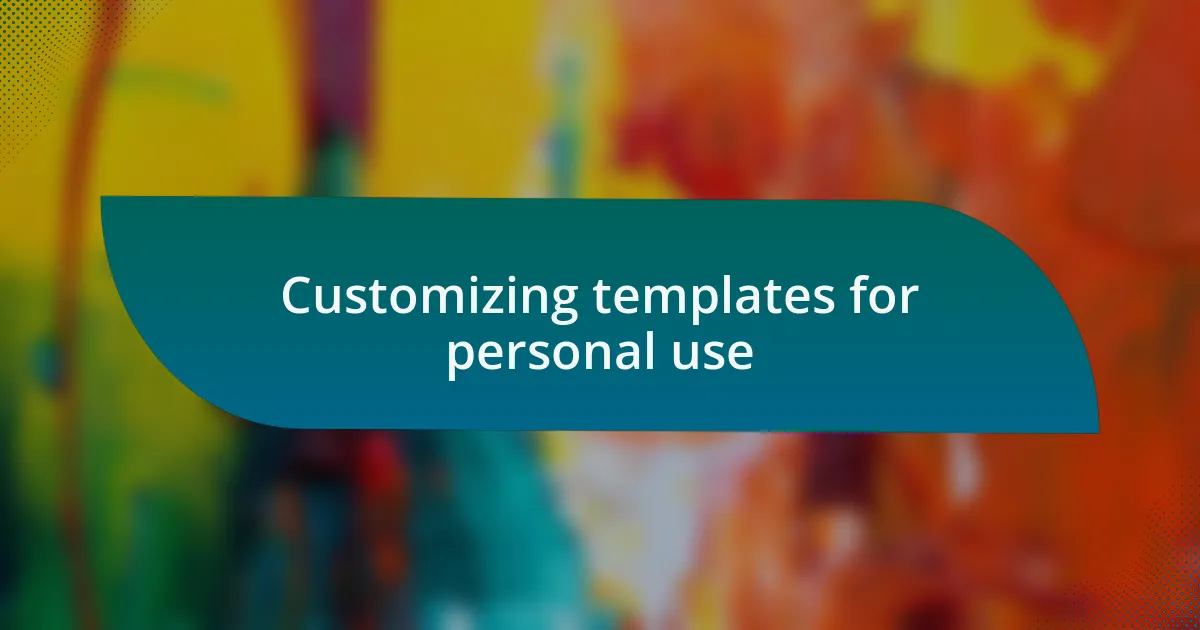
Customizing templates for personal use
When I customize a GIMP template for personal use, I dive deep into its elements, tailoring colors and fonts to reflect my unique style. I vividly remember tweaking a poster template for a friend’s birthday party; changing the color scheme to match the party theme brought it to life and made it much more personal. Have you ever felt that excitement when a template transforms into something distinctly yours?
Adjusting elements like layout and graphics can also significantly enhance a template’s impact. Once, I took a standard brochure template and rearranged its sections to better fit the narrative I wanted to convey for a local charity. This minor shift didn’t just improve clarity; it connected emotionally with the audience. How often do we overlook the importance of personal touches in design?
Additionally, I find that adding my own images or illustrations not only personalizes the template but also makes the design resonate more with my audience. For instance, customizing a social media template with photographs I’ve taken creates a storytelling aspect that’s uniquely mine. Have you experienced how your own images can breathe life into a design? It’s truly remarkable how personal touches can transform a simple template into a meaningful piece of art.
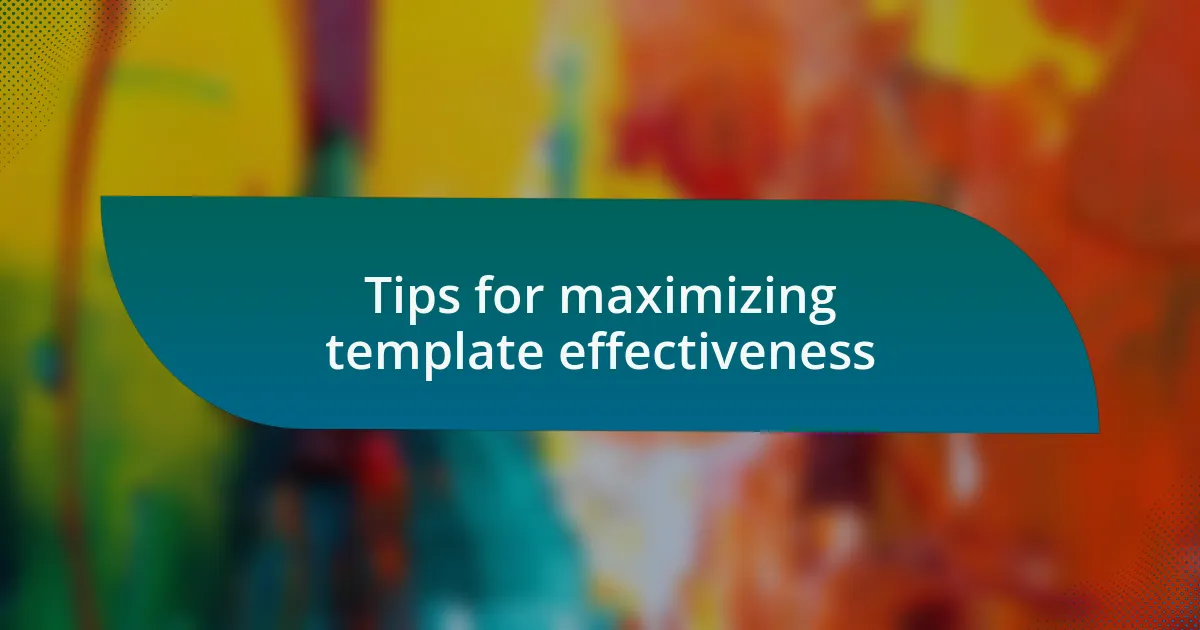
Tips for maximizing template effectiveness
One effective way to maximize a GIMP template’s effectiveness is to thoroughly examine all the layers and elements included in it. I distinctly remember a time when I accidentally overlooked a background layer that clashed with my main design. Once I adjusted that layer, the overall composition transformed into something harmoniously balanced. Have you ever felt like a simple tweak could change everything?
Utilizing GIMP’s tools, such as the path tool for precise adjustments, can elevate your designs in ways you might not expect. I once refined a template by outlining specific areas with the path tool, creating a seamless flow between text and visuals. This intricate detailing not only enhanced readability but also drew the viewer’s focus exactly where I wanted it. It’s fascinating how a subtle tool can make such a significant difference, don’t you think?
Moreover, exploring various export options and file formats is often overlooked but essential to achieving the right look for your final product. I’ve learned the hard way that exporting in the wrong format can compromise the quality of my work. For instance, choosing PNG over JPEG preserved the sharpness of the images in a poster I created, ultimately leaving a lasting impression on the audience. Have you considered how the format you choose affects your design’s effectiveness?